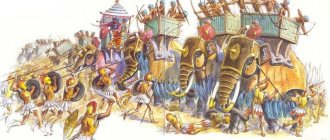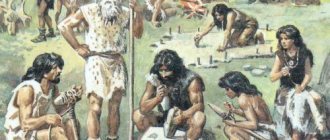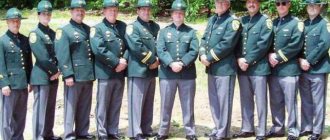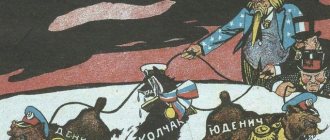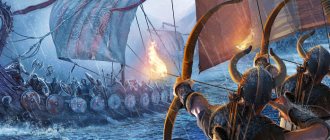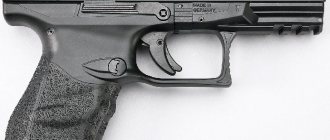Greek hoplites: who are they?
It is no secret that the history of the Ancient World consists almost entirely of armed conflicts and brutal wars. Each state sought to have its own combat-ready armies, and Greece was no exception. The bulk of its troops were hoplites - heavily armed foot soldiers. They first appeared in the army of Ancient Sparta. Greek hoplites were essentially citizen soldiers and served for the benefit of the city-state in which they lived.
In those days, military service was the duty of every man. Therefore, any meeting of citizens inevitably turned into a gathering of either veterans who had already served their time, or soldiers still in service at that time. It turns out that every citizen of a free policy sooner or later became a hoplite.
It must be said that these heavily armed infantrymen, starting in the 7th century and over the next four centuries, dominated the battlefields. It is known that before the father of Alexander the Great, King Philip II, hoplites were the basis of the classical phalanx.
In Ancient Greece, infantry was divided into several tactical units. The highest were the Moras, then the Lochs, which in turn were broken down into smaller units. The leaders commanding the pestilence were called polemarchs, and the suckers were called suckers.
Content
- 1 Preamble 1.1 Periods
- 1.2 Some sources
- 2.1 Citizens
- 3.1 Hoplites
- 4.1 Ships
- 5.1 Weapons
- 6.1 Military units
Armament
Greek hoplites always carried Argive shields, or hoplons. They were round in shape and weighed more than 8 kg. An interesting fact is that when fleeing, the warriors first of all threw their shields because of their excessive weight, so the loss of a hoplon was considered shameful for any hoplite. They were used not only to cover the body during battle, but also as stretchers on which wounded or dead comrades were placed.
Historians often associate the origin of the famous expression “with a shield or on a shield” with this Greek equipment. Most often, the hoplon consisted of a wooden base, which was upholstered on the outside with iron or bronze sheets, and covered with leather on the inside. It had comfortable handles through which the warrior's hand could be inserted. The main weapons of the hoplites were xiphos - straight short swords or mahairs - curved swords with a reverse bend. In addition, they were also supposed to carry cystons - three-meter spears for throwing.
Army composition[edit]
Hoplites[edit]
Hand-to-hand fighters. They went into battle lined up in a phalanx. The formation of the Greek army is precisely the formation of hoplites. Due to the relative slowness, they were supplemented with light troops.
The name came from the hoplon shield. Hoplon is a heavy shield made of hard wood, bound on the outside with bronze or even iron. A cheaper option - only the edge is bound. To carry such a shield in battle, you need to eat well and exercise a lot, so citizens of Greek city-states trained in gymnasiums from childhood. For a heavily armored hoplite to be effective in battle, a high level of motivation and discipline is required, since the phalanx - a dense shield formation - requires the ability to move and strike in a coordinated manner. The Greeks of the classical period encouraged comradeship and comradeship, fortitude and composure, and condemned daredevils who rushed into battle seeking personal glory.
Hoplite service was considered honorable and therefore hoplites were usually citizens. In addition, the hoplite armed and equipped himself at his own expense, so rich people of noble birth became hoplites. Hoplites usually traveled to the site on horseback, but fought on foot. The presence of horses did not add mobility to the detachment, since it was also followed by slaves on donkeys and mules, and even on foot.
Sarissophora
, the backbone of the Macedonian army - infantrymen armed with long sarissa pikes. They did not wear classic hoplon shields and, unlike ordinary hoplites, they were recruited from peasants and armed at the royal expense. Their appearance is associated with the military reforms of Philip of Macedon. During the reign of his predecessor Perdiccas III, the united Illyrians, Thracians and Paeons killed him, killed most of the Macedonian aristocracy and professional army and conquered half the country. As a result, Philip had to organize the recruitment of peasants into the army and establish their centralized training and weapons. Although their equipment and weapons were simplified, they proved to be more effective than traditional hoplites.
Hymnets[edit]
They could also be named after a specific type of weapon. They had no protective equipment—literally “naked.” They acted in loose formation, showering the enemy with shells.
For some time they were purely auxiliary troops, until the first victories over the hoplites occurred[2].
Peltasts[edit]
Mobile fighters, an intermediate option between hoplites and riflemen. They were often mercenaries (even to the point of being synonymous in some sources). They fought with shields and javelins, and were terrible both for archers, attacking with shields in close formation, and for hoplites, attacking from a distance.
The name came from the pelt shield: light, wicker, covered with leather.
There was a tendency to turn peltasts into universal "medium" infantry. Thus, the Athenian commander Iphicrates armed his peltasts with swords and linen armor and systematically taught them to act as a phalanx. In Alexander’s army, such “weighted” peltasts did not carry darts at all - the path for them was cleared not by their own fire, but by the shock royal cavalry. In a number of cases, they armed themselves with slings: cheap and cheerful, and there was plenty of ammunition everywhere.
Hippea[edit]
Cavalry - warriors on horseback. Most often she was completely absent - the commanders also walked. The Spartan cavalry consisted of two detachments of personal bodyguards of the kings, each containing 300 infantrymen[3]. The horsemen acted in small detachments (40 is already a large one) and were engaged in the pursuit of a defeated enemy, reconnaissance and various special assignments. But they rarely participated directly in battle.
Quite a rare branch of the army for the Greeks. For example, Xenophon, in his essay “On the Cavalry,” convinced the Athenians of the need to create a cavalry detachment altogether. But I wasn’t convinced: EXPENSIVE.
It should also be noted that stirrups had not yet been invented at that time, so the rider on the horse sat very unsteadily and was at great risk of falling off when, say, striking with a sword, or simply when maneuvering at high speed. Therefore, most often they fought by throwing darts from horseback, and if close combat was necessary, they preferred to dismount. This greatly limited the role of cavalry.
Hetaira[edit]
The word formation model is close to the Russian “druzhina”. Actually, initially this was the name given to the detachments of the personal guard of the Macedonian kings and aristocrats, similar to the princely squads. Initially, they either differed little from the Hippeis, or were also dart throwers. They were staffed by aristocrats.
During the military reforms of Philip of Macedon, they received heavier armor and weapons (weighted spears of more than two meters) and swords. Due to the huge losses among aristocratic families in the war against the Illyrians and Thracians, horse service became virtually mandatory for anyone who wanted to own land. Now they were taught to fight in formation as part of squadrons, striking with a spear from a horse, already in childhood, under the personal supervision of the king. They began to include foreigners well trained in military affairs - both Greeks and barbarians. For the first time in the history of Greece, cavalry began to be successfully used in battle, effectively complementing the impenetrable, but very clumsy and vulnerable to attacks from the rear and flanks.
Weapon production
Initially, the state did not care about providing its soldiers with weapons and even passed a law according to which every Greek hoplite (5th century BC) was obliged to equip himself at his own expense, although full uniform was expensive (about 30 drachmas). This amount was comparable to the monthly income of an artisan. Usually such expensive weapons were inherited.
By the way, its production in Ancient Greece flourished mainly in city policies, and it was imported into small settlements from other places. During the time of Pericles, a fairly large workshop operated in Athens, where they made shields. Perhaps this was the largest production in ancient Greece. About 120 slaves and a fairly large number of free citizens worked on it.
Preamble[edit]
Periods[edit]
Heroes and philosophers lived differently at different times. Your K.O.
- Ancient Ancient Greece, Age of Heroes. Source: Homer.
- Classical Ancient Greece, which the general reader knows best.
- Hellenism - first Sasha the Great, continuing the work of his father, conquered all of Greece, and then went to conquer everything he could reach in the south and east. And along the way, he spread Greek culture to barbaric countries like Egypt and Judea.
- Greece under Roman rule. The most respected colony.
Some sources[edit]
Greek hoplite armor
Initially, warriors wore Illyrian helmets, or skittles, on their heads. They were made of bronze and decorated with a horsehair comb. They were in use from the 7th to the 6th centuries. BC e., until they were replaced by Corinthian ones. The new helmets were completely closed and had openings only for the mouth and eyes. Outside of combat, they were usually moved to the back of the head. Later, Chalcidian helmets appeared, which also left the ears open. In the II century. BC e. The Thracian ones were considered the most popular - with a relatively small crest, complemented by figured cheekpieces and a visor.
The warrior's torso was protected in front and behind by an anatomical cuirass - a hippothorax. Most often it weighed about 1 talent (about 34 kg), but some soldiers had armor twice as heavy. Over time, the hippothorax was gradually replaced by a lighter version - a linen shell called linothorax.
Other parts of the body were also protected. Thus, Greek hoplites were equipped with greaves - cnimids, as well as bracers, which were used until the very middle of the 5th century. BC e. Proof of this fact are numerous archaeological finds discovered by scientists on the Peloponnesian Peninsula. On many amphorae and other household items, there were often images of a Greek hoplite (a photo of a fragment of such a vessel is presented below) fighting with a weapon in his hands against another enemy.
Fleet[edit]
Ships[edit]
A feature of naumachia (sea battle in ancient Greek) was that before the battle the masts were usually cut down, which excluded the use of sails in battle).
- Pentecontera is the workhorse of the Greek fleet, a sailing and rowing “long” ship for 50 people. Large universal boat for travel, transportation and war.
| "Round" and "long" |
| Accordingly, trade and military. The name reflected a design designed for either spaciousness or efficiency. |
- A triere is a ship with three rows of oars. A fast [4] and powerful ship, created specifically for war and combat on the water. The main weapon is the ram. The cruising speed at which long-distance voyages were carried out was only about 3 knots. Combat speed - 20 knots - for no more than a few minutes, that is, a jerk at maximum speed with the investment of all the forces that were saved, since the ship with exhausted rowers was absolutely helpless. Military transport ships are triremes, adapted for transporting soldiers (including horsemen). Slower than usual, but roomy.
- NB! From the name you might think that these are ships with four, five and six rows of oars - but this
. Historians are inclined to believe that the number in the name means the number of rowers in one vertical row of oars (for pentera - 2+2+1).
Sailors[edit]
Commanded the ship cybernet (helmsman)
.
He sat on the stern platform, from where it was convenient to give instructions to the helmsman
,
the propellers
on both sides, and
the kelevst
, the commander of the sailors.
A trierarch
could also stand above the helmsman - he commanded the trireme as a representative of the authorities.
Rowers[edit]
The most popular maritime profession is rower. At the same time he was a soldier, usually with a javelin or sling, in this capacity he defended his ship and participated in landings. The service of an oarsman was not considered particularly honorable, but was paid in the same way as a hoplite. Most often, mercenaries served as rowers, but there were also citizens, including in crews consisting entirely of citizens.
| Slavery |
| A popular myth not only about the Greeks, but about the Ancient World in general, is that chained slaves sat on oars. In fact, if this were so, the ship would not be able to fight, because, apart from the rowers, there was almost no one on it. Moreover, the ship was dragged ashore every night by the forces of the rowers, and did not remain on the water at anchor. |
Epibates[edit]
Sea hoplites. They served on ships in small groups (10-20 people) in case of hand-to-hand combat or battle with ground forces.
Naval weapons[edit]
- A ram is a striking weapon of a ship, the metal-bound head of a keel beam. Initially, they were used to hit the stern of the enemy ship (which required great skill of the entire crew and the cybernet in particular). During the Peloponnesian War, the Corinthians and Sicilians improved their weapons: the ram became longer and stronger, the bow set was strengthened and internal connections were added that distributed the impact energy throughout the entire structure. The seaworthiness had deteriorated somewhat, but now it was possible to hit it head-on without fear of falling apart. An epotida is a small ram attached to the stem above the main ram. Apparently, it protected the stem from hitting the side of the target ship.
Order of battle[edit]
With a large number and wide space of ships, the squadron was divided into a center and flanks, to which commanders were assigned. This achieved the deployment of mass and mutual support of individual ships. The battle in different sectors often proceeded independently - ships on one flank could defeat the enemy and get carried away in pursuit, not noticing that their comrades were being pursued on the opposite flank. Those who managed to notice and correct this mistake in time usually won.
Transformations in the army
In the 7th–5th centuries. BC e. a reform was carried out to make hoplite armor heavier. Most likely, such measures were taken in order to preserve the lives of the soldiers, since the Spartan army at that time consisted of only 8 moras, which is a little more than 4 thousand soldiers.
However, starting from the middle of the 5th century. BC e. The equipment of Greek soldiers began to be lighter: linen shells began to replace anatomical cuirasses. The bracers have almost completely disappeared. The reason for this was a change in the formation of troops. It became denser and deeper, and the number of soldiers in the detachments doubled. Only the number of Spartan formations remained unchanged - 144 soldiers each. Due to changes in formation, slashing blows were delivered less and less often, so the soldiers' hands were not in danger of being chopped off. Now piercing weapons were used more and more often, so the spears lengthened from 3 to 6 meters. So the Greek hoplites began to turn into sarissophoros - foot soldiers who formed the basis of the phalanx.
Traditions
Usually the Spartans set out on a campaign on a full moon, and before that their ruler always made a sacrifice so that good luck would accompany them. In front of the army they always carried fire taken from Sparta, which was necessary to light fires now for marching sacrifices. In addition, they took with them an image with the Dioscuri embracing. They personified the fraternal union of comrades in arms and were ideals for Spartan warriors.
The Greek army camp was almost always shaped like a circle and was well guarded by helots. It must be said that during the campaigns the Spartans dressed very smartly. Instead of the usual cloak made of rough fabric, they wore purple robes, and instead of parkas, they wore highly polished weapons. When entering battle, soldiers put on wreaths, as if going to some kind of holiday.
Army structure
Not only Greek hoplites served in the troops. You will find out further who the peltasts and slingers who helped the Spartans in battle were. Since the Greeks considered cavalry completely useless, horses were often used only to transport rich warriors to the battlefield. Therefore, in those days, in addition to heavy infantry (hoplites), there was also light infantry, consisting of the poorest townspeople and slaves. The latter, despite their forced existence, were quite reliable people, devoted to their masters.
Each hoplite always had his own slave who helped him put on his equipment. In battle, slaves were slingers who carried with them cloth bags with several dozen clay or stone cores with a diameter of up to 40 cm. They also had a special belt loop equipped with a thickening. This was the sling. She was expertly spun over her head and then released. The cannonball flew out and overtook the enemy at high speed, inflicting serious wounds on exposed parts of the body.
Throwers
Peltasts were light infantrymen armed with javelins. They were recruited from among the poorest townspeople called up for service, who did not have the opportunity to purchase hoplite weapons and armor. It happened that some of them purchased such uniforms at city expense.
The peltasts threw their weapons at a distance of about 15 m. They did not need a large supply of darts, since they only had time to use a few in the short time until the enemy approached closely. It must be said that a dart as a weapon was much more dangerous than an arrow, since, when it hit the enemy’s shield, it got stuck in it, preventing any defensive manipulations from being performed.
Physical training and education
As you know, Greek hoplites are militias who could hardly maintain formation while moving, and there was no talk of hand-to-hand combat skills. Of course, one can assume that free citizens engaged in some kind of physical exercise, but peasants had neither the opportunity nor the strength to constantly work on improving their bodies, especially upon reaching a more mature age.
The Spartans are another matter. From childhood, each of them was taught the art of war. They knew how to fight correctly and were rightly proud of it. Spartan hoplites not only knew how to impeccably maintain formation, in which they were helped by flute players, but also competently conducted hand-to-hand combat. They were almost the best warriors of the Ancient World.
Hoplites and Greek auxiliaries
In addition to heavy infantry and rather small cavalry, there were also light infantry in the Greek army. They were called peltastae or “armed with a pelta,” that is, a small round (or sickle-shaped) shield. They were armed with a bunch of darts and were used primarily for reconnaissance or sabotage operations, which usually involved hit-and-run tactics. Naturally, they could not hold back the enemy’s attack.
Among other things, the Greeks used archers, and in later eras these archers sometimes fought on horseback. The standing Athenian archery force was used primarily for police purposes, and was composed of Scythian slaves purchased with public funds from northern Greece. The Cretans were considered the best Greek archers, however, they did not take part in the largest military campaign of that time - the Greco-Persian Wars.

